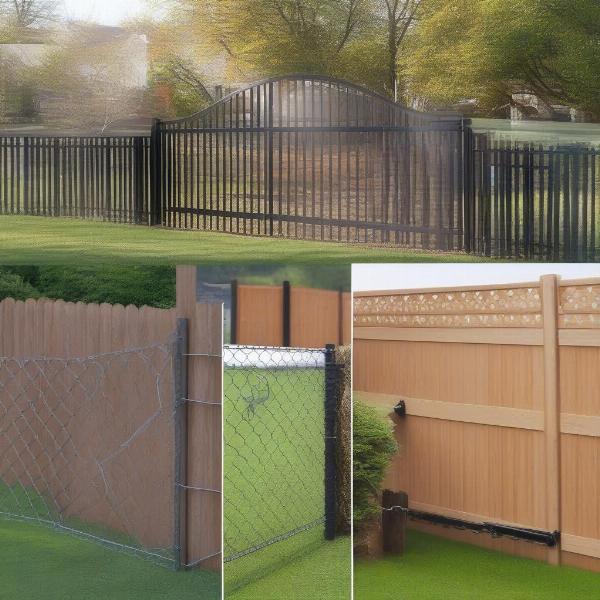Choosing the right dog fence can be a crucial decision for any pet owner. It’s about more than just keeping your dog contained; it’s about providing them with a safe and secure environment while also respecting your neighbors and community. Whether you have a tiny Chihuahua or a boisterous Great Dane, understanding the different types of dog fences, their pros and cons, and how to choose the best fit for your furry friend is essential. This guide will walk you through everything you need to know about dog fences, helping you make an informed decision that ensures your dog’s wellbeing and your peace of mind.
Types of Dog Fences: Finding the Perfect Fit for Your Furry Friend
There’s no one-size-fits-all solution when it comes to dog fences. The ideal choice depends on your dog’s breed, temperament, your property, and your budget. Let’s explore the most common options:
Traditional Fences: A Classic Choice
Traditional fences, like wooden, chain link, or vinyl, provide a physical barrier that’s both visible and durable. Wooden fences offer privacy and aesthetics, while chain link is a cost-effective and low-maintenance option. Vinyl fences provide a clean, modern look and are highly durable. However, some dogs can be climbers or diggers, so ensure the fence is high enough and securely anchored.
 Traditional Dog Fence Options
Traditional Dog Fence Options
Invisible Fences: A Hidden Boundary
Invisible or underground fences use buried wires to create a boundary that your dog learns to avoid through a training collar. They’re less visually obtrusive than traditional fences and can be a good option for properties where physical fences aren’t allowed. However, they don’t prevent other animals from entering your yard, and some dogs may be able to run through the boundary if sufficiently motivated.
Portable Dog Fences: Flexibility On-the-Go
portable dog fence offer a convenient and temporary solution for containing your dog in various locations, whether it’s at the park, on a camping trip, or even in your own backyard. They are easy to set up and take down, making them ideal for travel and temporary containment needs.
Electric Fences: A Deterrent for Escape Artists
dogs and electric fences can be a controversial option, but they can be effective in deterring persistent escape artists. They deliver a mild shock when the dog touches the fence, teaching them to avoid the boundary. It’s crucial to use these fences responsibly and humanely, with proper training and supervision.
Choosing the Right Dog Fence: Factors to Consider
Selecting the right dog barriers requires careful consideration of various factors. Your dog’s breed and temperament play a key role. A small, docile dog may be perfectly content with a low fence, while a larger, more energetic breed may require a taller and more secure option. Your property size and layout are also important.
Installation and Maintenance: Ensuring Long-Term Effectiveness
Proper installation and regular maintenance are essential for any dog fence. For traditional fences, ensure the posts are securely set and the materials are weather-resistant. With invisible fences, careful burying of the wire and regular testing of the system are crucial. Routine checks for damage and wear and tear will help keep your dog fence effective and safe for years to come.
Dog Fence Safety Tips
- Ensure the fence is appropriate for your dog’s size and breed.
- Regularly inspect the fence for any damage or weaknesses.
- Supervise your dog when they are in the fenced area, especially initially.
- Train your dog to understand the boundaries of the fence.
Conclusion: Creating a Safe Haven for Your Canine Companion
Choosing the right dog fence is a significant investment in your dog’s safety and wellbeing. By carefully considering your dog’s needs, your property, and your budget, you can create a secure and comfortable environment for your furry friend to thrive. Remember to consider your dog’s personality, your property, and the various fence options available. With careful planning and the right choice, you’ll have a secure and happy dog.
FAQ:
- What is the best type of fence for a dog that digs? A traditional fence that extends below ground or an invisible fence can be effective for diggers.
- How high should my dog fence be? The height depends on your dog’s breed and jumping ability.
- Are invisible fences safe for dogs? Yes, when used correctly and humanely, with proper training.
- Can I install a dog fence myself? Yes, but professional installation is recommended for some types, like invisible fences.
- How much does a dog fence cost? The cost varies depending on the type, size, and materials used.
- What is the best way to train my dog to use a new fence? Positive reinforcement and consistent training are key.
- What are garden barriers for dogs and how do they differ from dog fences? Garden barriers are designed to protect specific areas within a garden, while dog fences enclose a larger area.
Suggested Further Reading:
About ILM Dog:
ILM Dog is your trusted resource for comprehensive dog care information. We offer expert advice on everything from breed selection and health care to training and nutrition. Our mission is to empower dog owners with the knowledge and resources they need to provide the best possible care for their furry companions. Whether you’re a new dog owner or a seasoned pro, ILM Dog is here to support you every step of the way. For personalized advice and assistance, contact us at [email protected] or call us at +44 20-3965-8624.